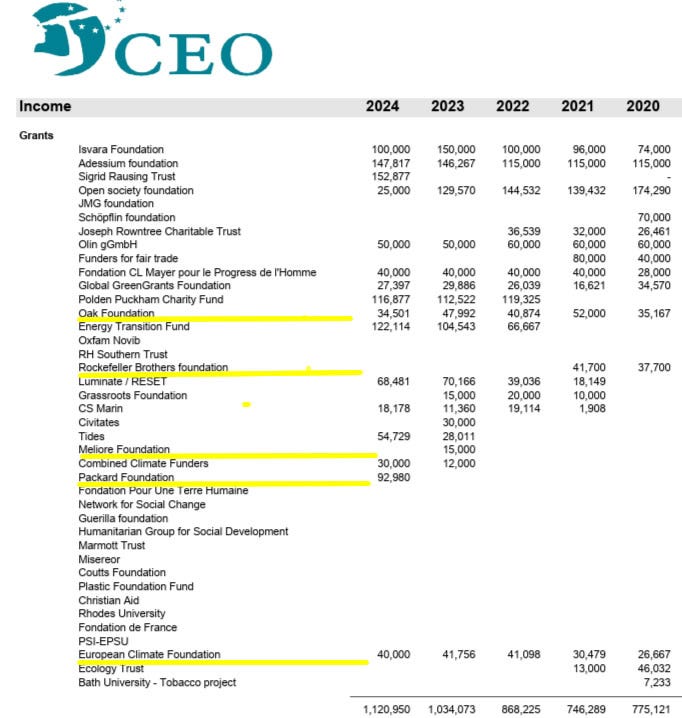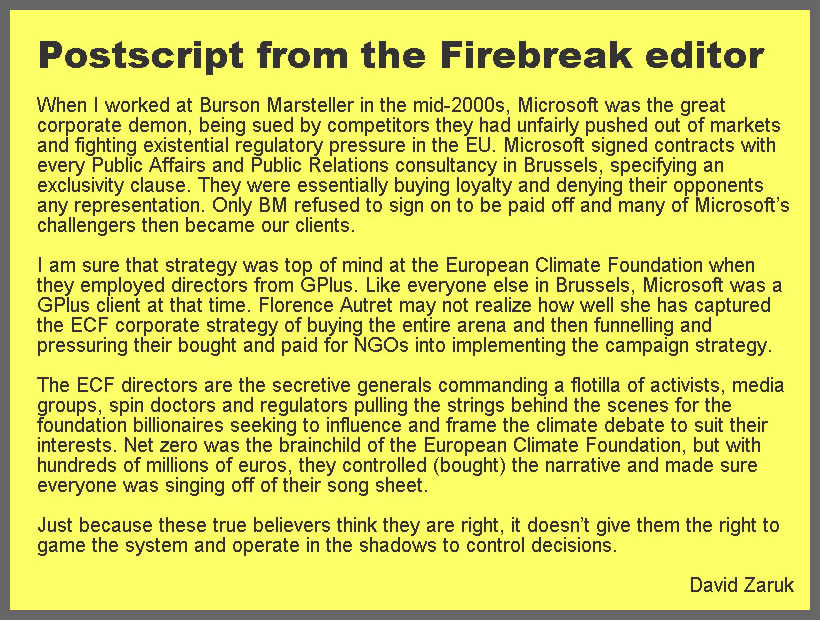The European Climate Foundation Influence "Value Chain"
Part 3/5: How to buy a large group of NGOs and make them dance for you
The European Climate Foundation (ECF) has dominated the climate debate in Europe and globally by funding environmental NGOs, using them like an “influence flotilla” to forward the agenda of large climate-driven foundations pulling the strings behind the scenes. The Firebreak has been conducting an ex-post evaluation on how the climate/net zero/ESG/WEF agenda over the last decade had almost succeeded in dismantling Western economic and political structures, and how a group of billionaires have been acting as a new power base, using their foundations to influence the media, politicians and NGOs. This translation of Florence Autret’s article, published in 2023, fits nicely within this objective. Her analysis is precise and insightful. For the purpose of considering each of the valuable points of her argument, the English translation has been broken into the following five chapters:
_________
Funding … with strings attached
NGO activist groups taking part in the European Climate Foundation millions face some challenging integrity questions. In 2022, employees of ECF-funded NGOs and their partners would only speak about this foundation’s support on the condition of anonymity.
“They bring in much-needed funding,” says one source. But “it’s a constant dilemma in NGOs. Sometimes the agendas align, sometimes you have to change direction a little bit.”
Another explains: “They’ve brought more foundations into the field. They’re taking a very active role. It can be jarring when they go beyond their financial role,” while lamenting that stable, multi-year funding has become rarer.
“Core funding began to melt away with the professionalization of philanthropy 10 years ago,” explains another. He adds: “I live better than if I had to convince 150,000 citizens each month to fund my organization.”
“When you know the discomfort of having one foot in action and the other in fundraising, grants, even annual ones, are generally welcome.”
Yet another activist goes further: “they are very good at putting bullet points in your mouth,” implying that his donors have sought to control his speech. “But it’s complicated. If you fall out with one, you fall out with all of them,” he says of the ECF members.
Buying NGOs in Bulk
Whereas fundraising has become much easier for NGOs with only one organization (and its foundation members), the consequence is that negotiations must occur at least annually.
“We are semi-wholesalers. We buy in bulk” the grant lines of large private foundations “and distribute them in smaller amounts,” qualifies an internal source at the ECF. “We are in contact with the NGO ecosystem, which the Oak Foundation, for example, cannot do from Geneva.”
A hell of a job considering that the grants can generally range from a few hundred thousand euros to two or three million, at most, while the Foundation has a budget of more than 100 million euros! The way in which the Oak, Ford and other foundations divide up the task and coordinate the management of this “portfolio” of NGOs is obviously not public.
Fund Managers (… trading in influence)
The ECF monitors the funded projects, “on an annual and thematic basis” thanks to a staff of experts organized into poles. According to an activist, each portfolio is placed under the control of a decision-making committee composed of “high-level managers” who associate members of the “staff”, in other words the technical experts who are, themselves, in constant contact with the NGOs.
In terms of volume, this trade in influence supports the comparison with the efforts deployed by Big Business, these large companies whose lobbying power in Brussels is notorious. That of the pharmaceutical industry was estimated by the anti-lobby lobby group, Corporate Europe Observatory (CEO), at 36 million euros per year, which corresponds to the expenses of the companies in the sector, their federations and their (more or less real) NGOs.
It should be noted that CEO benefits from the support of philanthropic foundations, including the ECF.

The Tangle of Membership, Sponsorship and Partnership
As a result of this management of donations, the landscape of environmental activism has become incredibly complex. It is almost impossible to find your way through this tangle of “membership”, “sponsorship”, “partnership”, varieties of funding. CAN Europe, for example, funded by ECF, brings together thousands of NGOs, at European and national level, including several national offices of WWF, all being in the group of “Green 10” (the group of 10 major climate organizations) of which WWF Europe is a member.
Another example: Transport & Environment (T&E), which has a budget of 10 million euros, receives support from the ECF and its Californian “sister” Climate Works (CW) but also from the KR, Hewlett, Oak, Rockefeller, Mercator foundations, etc., which also finance the ECF. T&E is also supported by the Packard Foundation, a donor to CW, and by the Schwab Charitable Fund.

The EEB, for its part, receives funds from the ECF, but also from the Laudes and Oak foundations.
This imbroglio of funding is coupled with a game of ad hoc coalitions. Formed according to legislative news, they create a mass effect, as here to attack the herbicide glyphosate.

Now that the European Climate Foundation has bought off almost all of the NGOs active in Brussels, they can turn their attention to the finance industry (as this exposé moves to Chapter 4: Carneyage).





